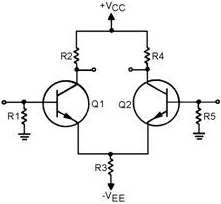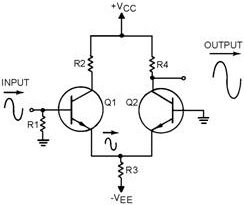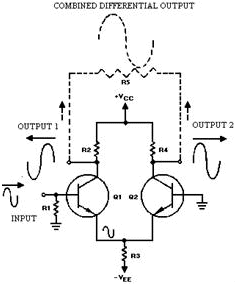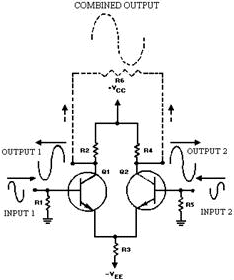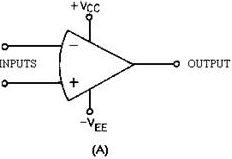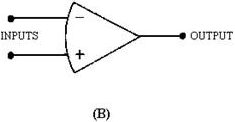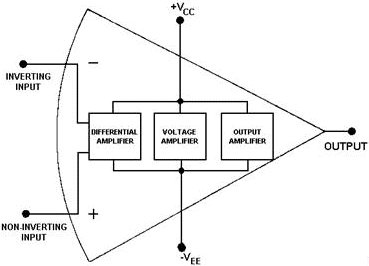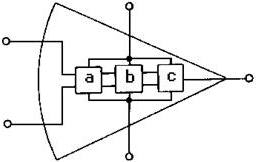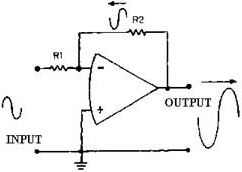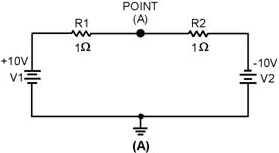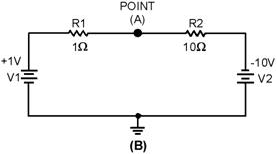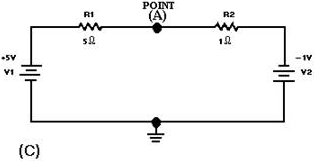Module 8 - Introduction to Amplifiers
|
||||||||||||||||||||||||||||||||||||||||||||||||||
|
Module 8 − Introduction to Amplifiers Pages i, 1−1, 1−11, 1−21, 1−31, 2−1, 2−11, 2−21, 2−31, 3−1, 3−11, 3−21, 3−31, 3−41, 3−51, 3−61, AI−1, Index
Figure 3-6. - Differential amplifier. Even though this circuit is designed to have two inputs and two outputs, it is not necessary to use both inputs and both outputs. (Remember, a differential amplifier was defined as having two possible inputs and two possible outputs.) a differential amplifier can be connected as a single-input, single-output device; a single-input, differential-output device; or a differential-input, differential-output device. Q-1. How many inputs and outputs are possible with a differential amplifier? Q-2. What two transistor amplifier configurations are combined in the single-transistor, two-input, single-output difference amplifier? Q-3. If the two input signals of a difference amplifier are in phase and equal in amplitude, what will the output signal be? Q-4. If the two input signals to a difference amplifier are equal in amplitude and 180 degrees out of phase, what will the output signal be? Q-5. If only one input signal is used with a difference amplifier, what will the output signal be? Q-6. If the two input signals to a difference amplifier are equal in amplitude but neither in phase nor 180 degrees out of phase, what will the output signal be? Single-Input, Single-Output, Differential Amplifier Figure 3-7 shows a differential amplifier with one input (the base of Q1) and one output (the collector of Q2). The second input (the base of Q2) is grounded and the second output (the collector of Q1) is not used. 3-11
Figure 3-7. - Single-input, single-output differential amplifier. When the input signal developed by R1 goes positive, the current through Q1 increases. This increased current causes a positive-going signal at the top of R3. This signal is felt on the emitter of Q2. Since the base of Q2 is grounded, the current through Q2 decreases with a positive-going signal on the emitter. This decreased current causes less voltage drop across R4. Therefore, the voltage at the bottom of R4 increases and a positive-going signal is felt at the output. When the input signal developed by R1 goes negative, the current through Q1 decreases. This decreased current causes a negative-going signal at the top of R3. This signal is felt on the emitter of Q2. When the emitter of Q2 goes negative, the current through Q2 increases. This increased current causes more of a voltage drop across R4. Therefore, the voltage at the bottom of R4 decreases and a negative- going signal is felt at the output. This single-input, single-output, differential amplifier is very similar to a single-transistor amplifier as far as input and output signals are concerned. This use of a differential amplifier does provide amplification of a.c. or d.c. signals but does not take full advantage of the characteristics of a differential amplifier. Single-Input, Differential-Output, Differential Amplifier In chapter one of this module you were shown several phase splitters. You should remember that a phase splitter provides two outputs from a single input. These two outputs are 180 degrees out of phase with each other. The single-input, differential-output, differential amplifier will do the same thing. Figure 3-8 shows a differential amplifier with one input (the base of Q1) and two outputs (the collectors of Q1 and Q2). One output is in phase with the input signal, and the other output is 180 degrees out of phase with the input signal. The outputs are differential outputs. 3-12
Figure 3-8. - Single-input, differential-output differential amplifier. This circuit's operation is the same as for the single-input, single-output differential amplifier just described. However, another output is obtained from the bottom of R2. As the input signal goes positive, thus causing increased current through Q1, R2 has a greater voltage drop. The output signal at the bottom of R2 therefore is negative going. a negative-going input signal will decrease current and reverse the polarities of both output signals. Now you see how a differential amplifier can produce two amplified, differential output signals from a single-input signal. One further point of interest about this configuration is that if a combined output signal is taken between outputs number one and two, this single output will be twice the amplitude of the individual outputs. In other words, you can double the gain of the differential amplifier (single output) by taking the output signal between the two output terminals. This single-output signal will be in phase with the input signal. This is shown by the phantom signal above R5 (the phantom resistor connected between outputs number one and two would be used to develop this signal). Differential-Input, Differential-Output, Differential Amplifier When a differential amplifier is connected with a differential input and a differential output, the full potential of the circuit is used. Figure 3-9 shows a differential amplifier with this type of configuration (differential-input, differential-output). 3-13
Figure 3-9. - Differential-input, differential-output differential amplifier. Normally, this configuration uses two input signals that are 180 degrees out of phase. This causes the difference (differential) signal to be twice as large as either input alone. (This is just like the two-input, single-output difference amplifier with input signals that are 180 degrees out of phase.) Output number one is a signal that is in phase with input number two, and output number two is a signal that is in phase with input number one. The amplitude of each output signal is the input signal multiplied by the gain of the amplifier. With 180-degree-out-of-phase input signals, each output signal is greater in amplitude than either input signal by a factor of the gain of the amplifier. When an output signal is taken between the two output terminals of the amplifier (as shown by the phantom connections, resistor, and signal), the combined output signal is twice as great in amplitude as either signal at output number one or output number two. (This is because output number one and output number two are 180 degrees out of phase with each other.) When the input signals are 180 degrees out of phase, the amplitude of the combined output signal is equal to the amplitude of one input signal multiplied by two times the gain of the amplifier.
When the input signals are not 180 degrees out of phase, the combined output signal taken across output one and output two is similar to the output that you were shown for the two-input, single-output, difference amplifier. The differential amplifier can have two outputs (180 degrees out of phase with each other), or the outputs can be combined as shown in figure 3-9. In answering Q7 through Q9 use the following information: All input signals are sine waves with a peak-to-peak amplitude of 10 millivolts. The gain of the differential amplifier is 10. Q-7. If the differential amplifier is configured with a single input and a single output, what will the peak-to-peak amplitude of the output signal be? 3-14 Q-8. If the differential amplifier is configured with a single input and differential outputs, what will the output signals be? Q-9. If the single-input, differential-output, differential amplifier has an output signal taken between the two output terminals, what will the peak-to-peak amplitude of this combined output be? In answering Q10 through Q14 use the following information: a differential amplifier is configured with a differential input and a differential output. All input signals are sine waves with a peak-to-peak amplitude of 10 millivolts. The gain of the differential amplifier is 10. Q-10. If the input signals are in phase, what will be the peak-to-peak amplitude of the output signals? Q-11. If the input signals are 180 degrees out of phase with each other, what will be the peak-to-peak amplitude of the output signals? Q-12. If the input signals are 180 degrees out of phase with each other, what will the phase relationship be between (a) the output signals and (b) the input and output signals? Q-13. If the input signals are 180 degrees out of phase with each other and a combined output is taken between the two output terminals, what will the amplitude of the combined output signal be? Q-14. If the input signals are 90 degrees out of phase with each other and a combined output is taken between the two output terminals, (a) what will the peak-to-peak amplitude of the combined output signal be, and (b) will the combined output signal be a sine wave? Operational Amplifiers An Operational Amplifier (OP AMP) is an amplifier which is designed to be used with other circuit components to perform either computing functions (addition, subtraction) or some type of transfer operation, such as filtering. Operational amplifiers are usually high-gain amplifiers with the amount of gain determined by feedback. Operational amplifiers have been in use for some time. They were originally developed for analog (non-digital) computers and used to perform mathematical functions. Operational amplifiers were not used in other devices very much because they were expensive and more complicated than other circuits. Today many devices use operational amplifiers. Operational amplifiers are used as d.c. amplifiers, a.c. amplifiers, comparators, oscillators (which are covered in NEETS, Module 9), filter circuits, and many other applications. The reason for this widespread use of the operational amplifier is that it is a very versatile and efficient device. As an integrated circuit (chip) the operational amplifier has become an inexpensive and readily available "building block" for many devices. In fact, an operational amplifier in integrated circuit form is no more expensive than a good transistor. Characteristics of an Operational Amplifier The schematic symbols for an operational amplifier are shown in figure 3-10. View (A) shows the power supply requirements while view (B) shows only the input and output terminals. An operational amplifier is a special type of high-gain, d.c. amplifier. To be classified as an operational amplifier, the circuit must have certain characteristics. The three most important characteristics of an operational amplifier are: 3-15 1. Very high gain 2. Very high input impedance 3. Very low output impedance
Figure 3-10A. - Schematic symbols of an operational amplifier.
Figure 3-10B. - Schematic symbols of an operational amplifier. Since no single amplifier stage can provide all these characteristics well enough to be considered an operational amplifier, various amplifier stages are connected together. The total circuit made up of these individual stages is called an operational amplifier. This circuit (the operational amplifier) can be made up of individual components (transistors, resistors, capacitors, etc.), but the most common form of the operational amplifier is an integrated circuit. The integrated circuit (chip) will contain the various stages of the operational amplifier and can be treated and used as if it were a single stage. Block Diagram of an Operational Amplifier Figure 3-11 is a block diagram of an operational amplifier. Notice that there are three stages within the operational amplifier. 3-16
Figure 3-11. - Block diagram of an operational amplifier. The input stage is a differential amplifier. The differential amplifier used as an input stage provides differential inputs and a frequency response down to d.c. Special techniques are used to provide the high input impedance necessary for the operational amplifier. The second stage is a high-gain voltage amplifier. This stage may be made from several transistors to provide high gain. a typical operational amplifier could have a voltage gain of 200,000. Most of this gain comes from the voltage amplifier stage. The final stage of the OP AMP is an output amplifier. The output amplifier provides low output impedance. The actual circuit used could be an emitter follower. The output stage should allow the operational amplifier to deliver several milliamperes to a load. Notice that the operational amplifier has a positive power supply (+VCC) and a negative power supply (-V EE). This arrangement enables the operational amplifier to produce either a positive or a negative output. The two input terminals are labeled "inverting input" (-) and "noninverting input" (+). The operational amplifier can be used with three different input conditions (modes). With differential inputs (first mode), both input terminals are used and two input signals which are 180 degrees out of phase with each other are used. This produces an output signal that is in phase with the signal on the noninverting input. If the noninverting input is grounded and a signal is applied to the inverting input (second mode), the output signal will be 180 degrees out of phase with the input signal (and one-half the amplitude of the first mode output). If the inverting input is grounded and a signal is applied to the noninverting input (third mode), the output signal will be in phase with the input signal (and one-half the amplitude of the first mode output). Q-15. What are the three requirements for an operational amplifier? 3-17 Q-16. What is the most commonly used form of the operational amplifier? Q-17. Draw the schematic symbol for an operational amplifier. Q-18. Label the parts of the operational amplifier shown in figure 3-12.
Figure 3-12. - Operational amplifier. Closed-Loop Operation of an Operational Amplifier Operational amplifiers can have either a closed-loop operation or an open-loop operation. The operation (closed-loop or open-loop) is determined by whether or not feedback is used. Without feedback the operational amplifier has an open-loop operation. This open-loop operation is practical only when the operational amplifier is used as a comparator (a circuit which compares two input signals or compares an input signal to some fixed level of voltage). As an amplifier, the open-loop operation is not practical because the very high gain of the operational amplifier creates poor stability. (Noise and other unwanted signals are amplified so much in open-loop operation that the operational amplifier is usually not used in this way.) Therefore, most operational amplifiers are used with feedback (closed-loop operation). Operational amplifiers are used with degenerative (or negative) feedback which reduces the gain of the operational amplifier but greatly increases the stability of the circuit. In the closed-loop configuration, the output signal is applied back to one of the input terminals. This feedback is always degenerative (negative). In other words, the feedback signal always opposes the effects of the original input signal. One result of degenerative feedback is that the inverting and noninverting inputs to the operational amplifier will be kept at the same potential. Closed-loop circuits can be of the inverting configuration or noninverting configuration. Since the inverting configuration is used more often than the noninverting configuration, the inverting configuration will be shown first. Inverting Configuration
Figure 3-13 shows an operational amplifier in a closed-loop, inverting configuration. Resistor R2 is used to feed part of the output signal back to the input of the operational amplifier. 3-18
Figure 3-13. - Inverting configuration. At this point it is important to keep in mind the difference between the entire circuit (or operational circuit) and the operational amplifier. The operational amplifier is represented by the triangle-like symbol while the operational circuit includes the resistors and any other components as well as the operational amplifier. In other words, the input to the circuit is shown in figure 3-13, but the signal at the inverting input of the operational amplifier is determined by the feedback signal as well as by the circuit input signal. As you can see in figure 3-13, the output signal is 180 degrees out of phase with the input signal. The feedback signal is a portion of the output signal and, therefore, also 180 degrees out of phase with the input signal. Whenever the input signal goes positive, the output signal and the feedback signal go negative. The result of this is that the inverting input to the operational amplifier is always very close to 0 volts with this configuration. In fact, with the noninverting input grounded, the voltage at the inverting input to the operational amplifier is so small compared to other voltages in the circuit that it is considered to be VIRTUAL Ground. (Remember, in a closed-loop operation the inverting and noninverting inputs are at the same potential.) Virtual ground is a point in a circuit which is at ground potential (0 volts) but is NOT connected to ground. Figure 3-14, (view A) (view B) and (view C), shows an example of several circuits with points at virtual ground.
Figure 3-14A. - Virtual ground circuits. 3-19
Figure 3-14B. - Virtual ground circuits.
Figure 3-14C. - Virtual ground circuits. In view (A), V1 (the left-hand battery) supplies +10 volts to the circuit while V2 (the right-hand battery) supplies -10 volts to the circuit. The total difference in potential in the circuit is 20 volts. The total resistance of the circuit can be calculated:
Now that the total resistance is known, the circuit current can be calculated: 3-20 |
||||||||||||||||||||||||||||||||||||||||||||||||||
